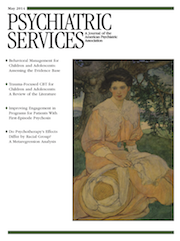Dis-ease and Disease: In Reply
In Reply: Dr. Combrinck-Graham raises a variety of issues in her letter. As they pertain to our study, she inquired about the diagnoses of the children of our participants and questioned the value of comparing the experiences of parents of younger children with the experiences of parents of older children. We feel it is important for the reader to understand that our study was not a study of the population; we did not compare the general experiences of parents of children to those of adults. Rather, this study assessed the experiences of help-seeking parents enrolled in the Family-to-Family (FTF) program of the National Alliance on Mental Illness. FTF is not a clinical service, does not involve medication, and is not targeted to children. Rather, it is a community-based program for parents and family members who are seeking support. “Mental illness” in our study was defined by the participants—parents who believed that their children had mental health issues. Parents in our study had reached the point of seeking help through FTF, and this study aimed to better understand the distress and difficulties of these parents. Thus the individual diagnoses of the children of the participants is not as relevant as the fact that all of the participants (parents), regardless of the ages of their children, felt that their children were struggling with mental health issues, and they themselves were looking for support through FTF, in most cases because of their concerns.
With respect to comparing different age groups, we agree that there are vast developmental differences between children who are young and children who are adults, but the fact that we uncovered significant differences when we split parents by the age of their children in our analyses, even though all of the parents were seeking the same community-based class within the same classroom, seems to justify the endeavor. Further, and consistent with Dr. Combrinck-Graham’s comments, if our study had had more statistical power, we would likely have found even more differences between parent subgroups if our analyses had split them further based on age.
We are glad that the overarching findings of more burden, distress, and difficulties among help-seeking parents in FTF of younger children do not come as a surprise to Dr. Combrinck-Graham, but we question whether these are well-known or universally accepted findings. More important, by examining specific areas of burden or concern in subgroups of FTF participants, this study can offer programs such as FTF additional information to fine-tune curricula for various groups of parents who are seeking support. Our findings suggest that certain concerns are more prevalent among parents of younger children than among parents of older children within FTF. Understanding that in this group of parents—all of whom were receiving the same curriculum and support through FTF—the parents of younger children had greater symptoms of depression and anxiety than the parents of older children as well as more concerns about their children’s potential for injury, attention-seeking behavior, and potential for suicide, for instance, could suggest refinements to the curriculum to better match the individual needs of a varied group of participants.



